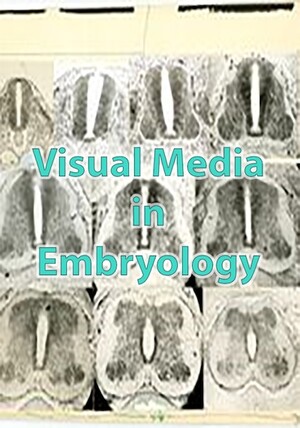Embryogenesis is inherently a process that unfolds through time. Every part of a living embryo is constantly in flux, making it challenging to describe them at any given point. To make sense of development, embryologists have used drawings and micrographs to create series of developmental stages. These staging systems are used to temporally orient specimens and as resources for communities of researchers investigating the same species. Often referred to as “normal stages,” these visual series are also used as standards of normal development against which the results of experiments can be compared.
Seeing with Multiple Mediums
- Landecker, H. (2006). Microcinematography and the History of Science and Film. Isis, 97(1), 121–132. http://doi.org/10.1086/501105
- Brauckmann, S. (2011). Cultures of seeing embryos and cells in 3-dimensions and flatness. Studies in History and Philosophy of Biological and Biomedical Sciences, 42(4), 365–367. http://doi.org/10.1016/j.shpsc.2011.07.010
- Brauckmann, S. (2012). On Fate and Specification: Images and Models in Developmental Biology. In N. Anderson & M. R. Dietrich (Eds.), The Educated Eye: Visual Culture and Pedagogy in the Life Sciences (pp. 213–234). Dartmouth College Press.
- Maienschein, Jane. 1991. “From Presentation to Representation in E. B. Wilson’s The Cell.” Biology and Philosophy 6 (2): 227-54.
Staging Development
- Hamburger, Viktor and Howard L. Hamilton. (1951). “A Series of Normal Stages in the Development of the Chick Embryo.” Journal of Morphology 88(3): 49-92.
- Hopwood, N. (2005). Visual Standards and Disciplinary Change: Normal plates, Tables and Stages in Embryology. History of Science, 43, 239–303.
Looking at Cells
Wilson and Conklin: Tracing Cell Lineages
- Conklin, E. G. (1897). The Embryology of Crepidula: A Contribution to the Cell Lineage and Early Development of Some Marine Gasteropods. Journal of Morphology, 13(1), 1–226.
- B. Wilson, E. (1892). The cell-lineage of Nereis: A contribution to the cytogeny of the annelid body. Journal of Morphology, 6(3), 361–481.
Holtfreter: Observing Cells
- Holtfreter, Johannes. (1943). “A study of the mechanics of gastrulation Part I.” Journal of Experimental Zoology 94: 261-318.
- Holtfreter, Johannes. (1944). “A study of the mechanics of gastrulation Part II.” Journal of Experimental Zoology 95: 171-212.
- Hamburger, Viktor. (1996). “Introduction: Johannes Holtfreter, Pioneer in Experimental Embryology.” Developmental Dynamics 205: 214-216.
- Gerhart, John. (1998). “Johannes Holtfreter: January 9, 1901–November 13, 1992,” Biographical Memoirs National Academy of Sciences 73: 209–28.
Trinkaus: Filming Embryos
- Trinkaus, John Philip. "Surface activity and locomotion of Fundulus deep cells during blastula and gastrula stages." Developmental Biology 30 (1973): 68–103.
- Trinkaus, John Philip. "The yolk syncytial layer of Fundulus: Its origin and history and its significance for early embryogenesis." Journal of Experimental Zoology 265 (1993): 258–84.
Experimenting on Embryos
Exogastrulas
- Gerhart, John. (1998). “Johannes Holtfreter: January 9, 1901–November 13, 1992,” Biographical Memoirs National Academy of Sciences 73: 209–28.
Transplating Limb Buds
- Allen, Garland E. (2004). “A Pact with the Embryo: Viktor Hamburger, Holistic and Mechanistic Philosophy in the Development of Neuroembryology, 1927-1955.” Journal of the History of Biology 37: 421-474
- Hamburger, Viktor. (1934). ‘‘The Effects of Wing Bud Extirpation on the Development of the Central Nervous System in Chick Embryos.’’ Journal of Experimental Zoology 68: 449–494.
- Hamburger, Viktor. (1938). ‘‘Morphogenetic and Axial Self-differentiation of Transplanted Limb Primordia of Two-day Chick Embryos.’’ Journal of Experimental Zoology 77: 379–397

